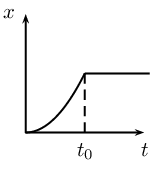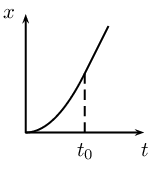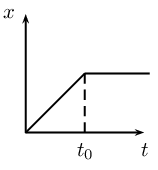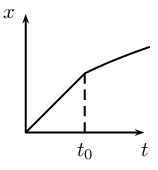Give one word/term for the following descriptions.
-
The shortest path from start to finish.
-
A physical quantity with magnitude and direction.
-
The quantity defined as a change in velocity over a time
period.
-
The point from where you take measurements.
-
The distance covered in a time interval.
-
The velocity at a specific instant in time.
Solution not yet available
Choose an item from column B that match the description in column A. Write
down only the letter next to the question number. You may use an item
from column B more than once.
Solution not yet available
Indicate whether the following statements are TRUE or FALSE. Write only
“true” or “false”. If the statement is false,
write down the correct statement.
-
A scalar is the displacement of an object over a time
interval.
-
The position of an object is where it is located.
-
The sign of the velocity of an object tells us in which
direction it is travelling.
-
The acceleration of an object is the change of its
displacement over a period in time.
Solution not yet available
[SC 2003/11] A body accelerates uniformly from rest for \({t}_{0}\) seconds
after which it continues with a constant velocity. Which graph is the
correct representation of the body's motion?
Solution not yet available
[SC 2003/11] The velocity-time graphs of two cars are represented by \(P\)
and \(Q\) as shown
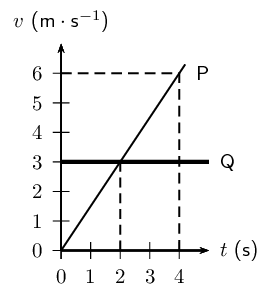
The difference in the distance travelled by the two cars (in m) after
\(\text{4}\) \(\text{s}\) is \(...\)
-
\(\text{12}\)
-
\(\text{6}\)
-
\(\text{2}\)
-
\(\text{0}\)
Solution not yet available
[IEB 2005/11 HG] The graph that follows shows how the speed of an athlete
varies with time as he sprints for \(\text{100}\) \(\text{m}\).

Which of the following equations can be used to correctly determine the time
t for which he accelerates?
-
\(100=\left(10\right)\left(11\right)-\frac{1}{2}\left(10\right)t\)
-
\(100=\left(10\right)\left(11\right)+\frac{1}{2}\left(10\right)t\)
-
\(100=10t+\frac{1}{2}\left(10\right){t}^{2}\)
-
\(100=\frac{1}{2}\left(0\right)t+\frac{1}{2}\left(10\right){t}^{2}\)
Solution not yet available
[SC 2002/03 HG1]
In which one of the following cases will the distance covered and the
magnitude of the displacement be the same?
-
A girl climbs a spiral staircase.
-
An athlete completes one lap in a race.
-
A raindrop falls in still air.
-
A passenger in a train travels from Cape Town to
Johannesburg.
Solution not yet available
[SC 2003/11] A car, travelling at constant velocity, passes a stationary
motor cycle at a traffic light. As the car overtakes the motorcycle, the
motorcycle accelerates uniformly from rest for \(\text{10}\)
\(\text{s}\). The following displacement-time graph represents the
motions of both vehicles from the traffic light onwards.
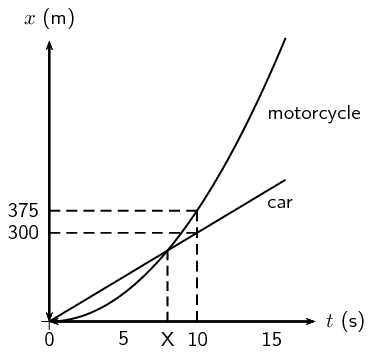
-
Use the graph to find the magnitude of the constant velocity
of the car.
-
Use the information from the graph to show by means of
calculation that the magnitude of the acceleration of
the motorcycle, for the first 10 s of its motion is
\(\text{7,5}\) \(\text{m·s$^{-2}$}\).
-
Calculate how long (in seconds) it will take the motorcycle
to catch up with the car (point \(X\)
-
How far behind the motorcycle will the car be after
\(\text{15}\) seconds?
Solution not yet available
[IEB 2005/11 HG] Which of the following statements is true of a body
that accelerates uniformly?
-
Its rate of change of position with time remains constant.
-
Its position changes by the same amount in equal time
intervals.
-
Its velocity increases by increasing amounts in equal time
intervals.
-
Its rate of change of velocity with time remains constant.
Solution not yet available
[IEB 2003/11 HG1] The velocity-time graph for a car moving along a straight
horizontal road is shown below.
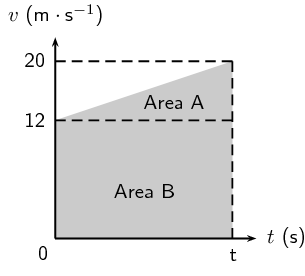
Which of the following expressions gives the magnitude of the average
velocity of the car?
-
\(\frac{\text{Area } A}{t}\)
-
\(\frac{\text{Area } A + \text{ Area } B}{t}\)
-
\(\frac{\text{Area } B}{t}\)
-
\(\frac{\text{Area } A - \text{ Area }B}{t}\)
Solution not yet available
[SC 2002/11 SG] A car is driven at 25 \(\text{m·s$^{-1}$}\) in a
municipal area. When the driver sees a traffic officer at a speed trap,
he realises he is travelling too fast. He immediately applies the brakes
of the car while still \(\text{100}\) \(\text{m}\) away from the speed
trap.
-
Calculate the magnitude of the minimum acceleration which the
car must have to avoid exceeding the speed limit, if the
municipal speed limit is \(\text{16,6}\)
\(\text{m·s$^{-1}$}\).
-
Calculate the time from the instant the driver applied the
brakes until he reaches the speed trap. Assume that the
car's velocity, when reaching the trap, is
\(\text{16,6}\) \(\text{m·s$^{-1}$}\).
Solution not yet available
A traffic officer is watching his speed trap equipment at the bottom of a
valley. He can see cars as they enter the valley \(\text{1}\)
\(\text{km}\) to his left until they leave the valley \(\text{1}\)
\(\text{km}\) to his right. Nelson is recording the times of cars
entering and leaving the valley for a school project. Nelson notices a
white Toyota enter the valley at
\(\text{11}\):\(\text{01}\):\(\text{30}\) and leave the valley at
\(\text{11}\):\(\text{02}\):\(\text{42}\). Afterwards, Nelson hears that
the traffic officer recorded the Toyota doing \(\text{140}\)
\(\text{km·h$^{-1}$}\).
-
What was the time interval (\(\Delta t\)
-
What was the average speed of the Toyota?
-
Convert this speed to \(\text{km·h$^{-1}$}\)
-
Discuss whether the Toyota could have been travelling at
\(\text{140}\) \(\text{km·h$^{-1}$}\) at the bottom
of the valley.
-
Discuss the differences between the instantaneous speed (as
measured by the speed trap) and average speed (as
measured by Nelson).
Solution not yet available
[IEB 2003/11HG] A velocity-time graph for a ball rolling along a track is
shown below. The graph has been divided up into \(\text{3}\) sections,
A, B and C for easy reference. (Disregard any effects of friction.)
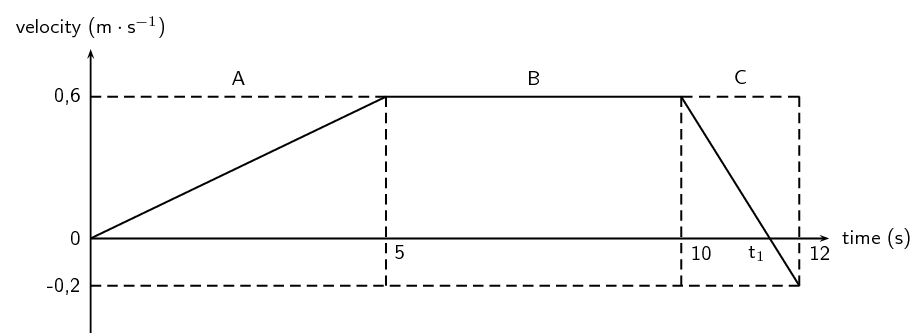
-
Use the graph to determine the following:
-
the speed \(\text{5}\) \(\text{s}\) after the
start
-
the distance travelled in Section A
-
the acceleration in Section C
-
At time \({t}_{1}\)\({t}_{1}\)
-
Sketch a displacement-time graph for the motion of the ball
for these \(\text{12}\) \(\text{s}\). (You do not need
to calculate the actual values of the displacement for
each time interval, but do pay attention to the general
shape of this graph during each time interval.)
Solution not yet available
In towns and cities, the speed limit is \(\text{60}\)
\(\text{km·h$^{-1}$}\). The length of the average car is
\(\text{3,5}\) \(\text{m}\), and the width of the average car is
\(\text{2}\) \(\text{m}\). In order to cross the road, you need to be
able to walk further than the width of a car, before that car reaches
you. To cross safely, you should be able to walk at least \(\text{2}\)
\(\text{m}\) further than the width of the car (\(\text{4}\)
\(\text{m}\) in total), before the car reaches you.
-
If your walking speed is \(\text{4}\)
\(\text{km·h$^{-1}$}\), what is your walking speed
in \(\text{m·s$^{-1}$}\)?
-
How long does it take you to walk a distance equal to the
width of the average car?
-
What is the speed in \(\text{m·s$^{-1}$}\) of a car
travelling at the speed limit in a town?
-
How many metres does a car travelling at the speed limit
travel, in the same time that it takes you to walk a
distance equal to the width of car?
-
Why is the answer to the previous question important?
-
If you see a car driving toward you, and it is \(\text{28}\)
\(\text{m}\) away (the same as the length of
\(\text{8}\) cars), is it safe to walk across the road?
-
How far away must a car be, before you think it might be safe
to cross? How many car-lengths is this distance?
Solution not yet available
A bus on a straight road starts from rest at a bus stop and accelerates at
\(\text{2}\) \(\text{m·s$^{-2}$}\) until it reaches a speed of
\(\text{20}\) \(\text{m·s$^{-1}$}\). Then the bus travels for
\(\text{20}\) \(\text{s}\) at a constant speed until the driver sees the
next bus stop in the distance. The driver applies the brakes, stopping
the bus in a uniform manner in \(\text{5}\) \(\text{s}\).
-
How long does the bus take to travel from the first bus stop
to the second bus stop?
-
What is the average velocity of the bus during the trip?
Solution not yet available

